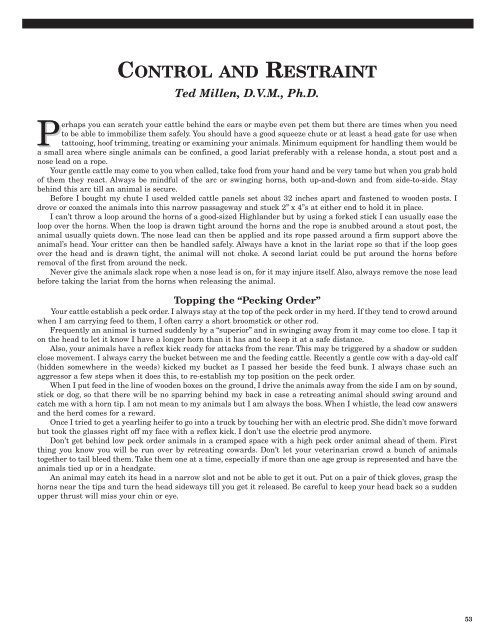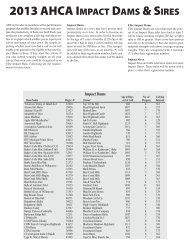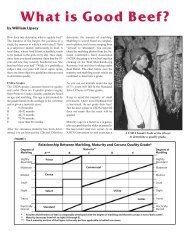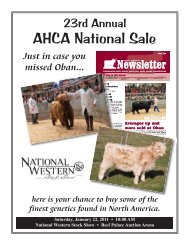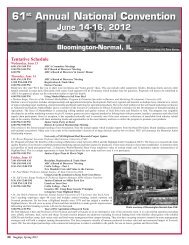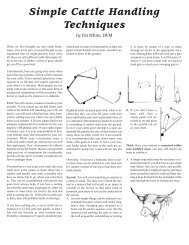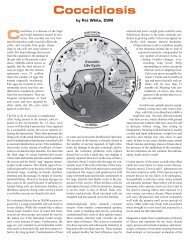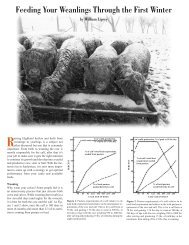The Bagpipe - American Highland Cattle Association
The Bagpipe - American Highland Cattle Association
The Bagpipe - American Highland Cattle Association
Create successful ePaper yourself
Turn your PDF publications into a flip-book with our unique Google optimized e-Paper software.
CONTROL AND RESTRAINT<br />
Ted Millen, D.V.M., Ph.D.<br />
Perhaps you can scratch your cattle behind the ears or maybe even pet them but there are times when you need<br />
to be able to immobilize them safely. You should have a good squeeze chute or at least a head gate for use when<br />
tattooing, hoof trimming, treating or examining your animals. Minimum equipment for handling them would be<br />
a small area where single animals can be confined, a good lariat preferably with a release honda, a stout post and a<br />
nose lead on a rope.<br />
Your gentle cattle may come to you when called, take food from your hand and be very tame but when you grab hold<br />
of them they react. Always be mindful of the arc or swinging horns, both up-and-down and from side-to-side. Stay<br />
behind this arc till an animal is secure.<br />
Before I bought my chute I used welded cattle panels set about 32 inches apart and fastened to wooden posts. I<br />
drove or coaxed the animals into this narrow passageway and stuck 2” x 4”s at either end to hold it in place.<br />
I can’t throw a loop around the horns of a good-sized <strong>Highland</strong>er but by using a forked stick I can usually ease the<br />
loop over the horns. When the loop is drawn tight around the horns and the rope is snubbed around a stout post, the<br />
animal usually quiets down. <strong>The</strong> nose lead can then be applied and its rope passed around a firm support above the<br />
animal’s head. Your critter can then be handled safely. Always have a knot in the lariat rope so that if the loop goes<br />
over the head and is drawn tight, the animal will not choke. A second lariat could be put around the horns before<br />
removal of the first from around the neck.<br />
Never give the animals slack rope when a nose lead is on, for it may injure itself. Also, always remove the nose lead<br />
before taking the lariat from the horns when releasing the animal.<br />
Topping the “Pecking Order”<br />
Your cattle establish a peck order. I always stay at the top of the peck order in my herd. If they tend to crowd around<br />
when I am carrying feed to them, I often carry a short broomstick or other rod.<br />
Frequently an animal is turned suddenly by a “superior” and in swinging away from it may come too close. I tap it<br />
on the head to let it know I have a longer horn than it has and to keep it at a safe distance.<br />
Also, your animals have a reflex kick ready for attacks from the rear. This may be triggered by a shadow or sudden<br />
close movement. I always carry the bucket between me and the feeding cattle. Recently a gentle cow with a day-old calf<br />
(hidden somewhere in the weeds) kicked my bucket as I passed her beside the feed bunk. I always chase such an<br />
aggressor a few steps when it does this, to re-establish my top position on the peck order.<br />
When I put feed in the line of wooden boxes on the ground, I drive the animals away from the side I am on by sound,<br />
stick or dog, so that there will be no sparring behind my back in case a retreating animal should swing around and<br />
catch me with a horn tip. I am not mean to my animals but I am always the boss. When I whistle, the lead cow answers<br />
and the herd comes for a reward.<br />
Once I tried to get a yearling heifer to go into a truck by touching her with an electric prod. She didn’t move forward<br />
but took the glasses right off my face with a reflex kick. I don’t use the electric prod anymore.<br />
Don’t get behind low peck order animals in a cramped space with a high peck order animal ahead of them. First<br />
thing you know you will be run over by retreating cowards. Don’t let your veterinarian crowd a bunch of animals<br />
together to tail bleed them. Take them one at a time, especially if more than one age group is represented and have the<br />
animals tied up or in a headgate.<br />
An animal may catch its head in a narrow slot and not be able to get it out. Put on a pair of thick gloves, grasp the<br />
horns near the tips and turn the head sideways till you get it released. Be careful to keep your head back so a sudden<br />
upper thrust will miss your chin or eye.<br />
53


